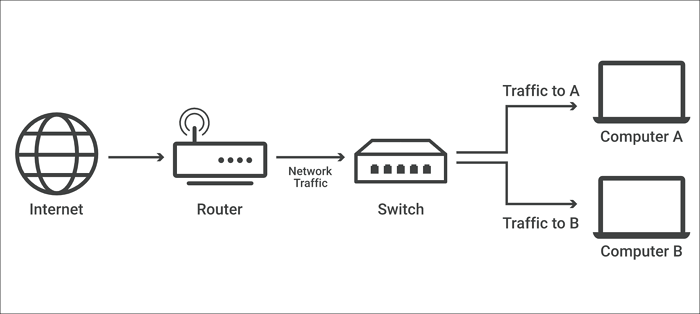Do you desire to add more ports and connect more devices to your existing network? Then all you need is a network switch. It not only transfers data between your devices but also keeps a record of connected devices. In addition, it can act as a bridge between two Local Area Networks (LAN).
As you read, you will acquaint yourself with the types of network switches and their uses.
What is a Network Switch?
A network switch (also known as bridging or switching hub) is hardware that connects more than one IT device to a computer network through packet switching, multiport bridge system, and MAC address identification. It enhances communications and IT resource sharing between connected devices.
Unlike a router, a network switch sends information to a single device (router, another switch, computer, etc.) it was designed for. It accepts packets from access points (linked to the physical ports) and sends them through dedicated ports to the destination device.
In addition, network switches work at Layer 2 (data link) of the OSI (Open Systems Interconnection) and can also function at Layer 3, where routing occurs. Nowadays, most switches use Ethernet, even though they are also standard components of InfiniBand, fiber channels, and ATM (Asynchronous Transfer Mode).

In contrast to popular opinions, network switches may be software-based/virtual and hardware devices that govern the physical system in a workplace. They connect industrial machinery, desktop PCs, IoT (internet of things) devices such as card entry systems, and wireless access points.
Today, switches make up the majority of network equipment; they connect servers, storage devices, and most of the virtual machines in data centers. In the Telecommunication industry, network switches are responsible for transferring massive volumes of data.
Reading this article below helps you learn more about data transfer.
How to Transfer Files from PC to PC [Full Guide with Pictures]
Are you looking for a way to transfer files from PC to PC? This guide provides you with every way to transfer files from one computer to another on Windows 10 and 11. Read on, and you will know how to transfer files from an old PC to a new PC on a Windows computer.

Types of Network Switches and Their Uses
Some types of network switches are:
1. Unmanaged switches
Unlike managed switches, they are cheaper with set configurations; often used to expand LAN's Ethernet connection and transmit data via MAC addresses to local devices. User has few alternatives, and poor capability makes them unreliable for enterprise applications.
2. Managed switches
These are popular in enterprise settings because they enable administrators to perform dynamic configurations like creating virtual LANs for splitting local networks into smaller parts. Also, troubleshooting information is enabled by its protocol agents.
3. Smart switches
A miniature but less expensive version of the conventionally managed switch, they are more advanced than an unmanaged switch. They are suitable for small networks with fewer features and budgets than fully controllable ones.
4. LAN (Local Area Network) switches
It is also known as Ethernet or data switch because they link locations on an internal LAN and prevent overlapping of data packets traveling through a network. This is achieved by allocating bandwidth efficiently, after which the LAN switch delivers the delivered data packet to its intended destination.
5. Modular switches
Using this type of network switch enables the addition of extension modules for greater flexibility as the network expands. Although they are more expensive than fixed ones, they are helpful in massive and growing networks looking to add modules like firewalls, wireless connections, and network analysis to a preexisting switch.
6. Stackable switches
Stackable switches speak to optimization and reliability by functioning as a single switch through a cluster of switches. They are powered by one RMON/SNMP agent, one domain, one Web Interface, or CLI (Command Line Interface).
7. Fixed-configuration switches
Just as the name sounds, these switches have a fixed number of ports that cannot be expanded or increased, making them affordable compared to others. Port speeds are usually at least 1Gbps, with options to connect using either optical fibers or wired RJ45 electrical ports.
8. Power over Ethernet (PoE) switches
PoE is used to supply power (DC) to low-power devices in the network. It means low-power devices will not need additional power outlets from a power supply, making installing IoT devices simpler, faster, and safer.
9. Data center switches
Data center switches have become more prevalent in recent years due to their high speed, low latency, huge port capacity, virtualization support, QoS, and security. Today, most organizations consolidate their networks and IT assets into several large data centers for better management.
10. Layer three switches
These are part of the Layer 2 layer of the OSI model; they are also known as Layer three switches because they work at the Network Layer of the model. It is a hybrid of the Layer 2 and 3 devices, and its software is more complex than its traditional counterpart.
The Uses of Network Switches?
By discretion, IT managers must choose the types of network switches based on their use cases.
Connection with a specific or multiple hosts
Although many other devices contribute to data transportation, the switch is critical in networking design. All ports on the switch have the exact mechanism (Forwarding and filtering), and users can connect to multiple switches using different ports. Also, they can operate each network switch individually in the same group setup.
Optimize LAN Bandwidth
Effective switching is needed to handle increased network traffic from bandwidth-intensive applications, video, user devices, and packets destined for cloud storage and servers. Network switches divide LAN networks into separate broadband connections to increase their frequency. Users can enjoy speed and reliability with LAN switching.
Traffic control
Network switches help offload traffic entering/leaving or connecting many network devices. Routing network traffic is possible between at least two different ports connected to separate devices; this is known as Forwarding.
Populate MAC address table
Another use case of network switches is that though the MAC address database is usually empty at the onset, it is populated with both the switch port collecting the data packet and the source (MAC) addresses. Eventually, the network switch has a fully populated MAC address database as resource sharing goes on between connected devices.
Final Words
Globally, the knowledge of network switches will be essential in the coming years because of its critical role in maintaining and stabilizing resource distribution in large-scale computing environments. The content of this article will come in handy in knowing what a network switch is, the types of network switches that exist, and their individual use cases.
Was This Page Helpful?
Daisy is the Senior editor of the writing team for EaseUS. She has been working at EaseUS for over ten years, starting as a technical writer and moving on to being a team leader of the content group. As a professional author for over ten years, she writes a lot to help people overcome their tech troubles.
Related Articles
-
What is the Thinking Behind 32GB Windows Format Limit on FAT32?
 Daisy/2024-01-11
Daisy/2024-01-11 -
Incremental Backup Advantages and Disadvantages [2024 Thorough Reviews]
 Jerry/2024-07-01
Jerry/2024-07-01 -
What Is the SysWOW64 Folder? SysWOW64 vs System32
 Daisy/2024-01-11
Daisy/2024-01-11 -
Fix: Operation Failed with Error 0x0000011b (Windows 10/11)
 Daisy/2024-01-11
Daisy/2024-01-11
